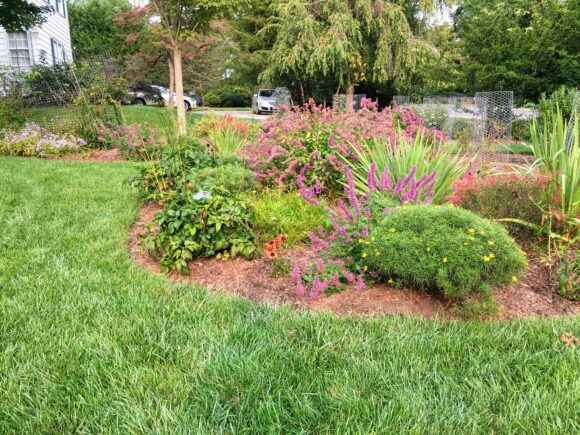 By Agriculture and natural resources county agents Amy Rowe (Essex and Passaic) and Michele Bakacs (Middlesex and Union)
By Agriculture and natural resources county agents Amy Rowe (Essex and Passaic) and Michele Bakacs (Middlesex and Union)
Making the transition to organic land care may seem intimidating to the average homeowner who maintains their own lawn and landscape. Many misconceptions exist about organic landscaping. Perhaps you have questions whether “that stuff really works” or perhaps you fear your yard turning into a hotbed of weeds and pests.
Organic land care is not simply about substituting organic-approved products for synthetic materials, i.e., just because you are using an organic pesticide on a lawn does not mean the lawn is organic. Organic land care involves treating your landscape as a whole living system where the soil, plants, and animals within that system are interdependent and sustain each other. This type of thinking is based in ecology – the study of the relationships that living organisms have with each other and the nonliving environment. When transitioning to an organic landscape, the goal should be to create a healthy ecosystem that is self-sustaining with few material or product inputs. The objective is to eliminate the use of synthetic pesticides, synthetic fertilizers, and synthetic soil amendments.
How should a homeowner start the transition to organic landscaping? It all starts with healthy soil. A healthy soil translates into healthy plants and turf. The soil contains living organisms which make up the life of the soil and range from worms and insects to bacteria. The activity of these soil organisms, termed “biological activity,” releases nutrients and makes them available for plant uptake. The biological activity starts with insects and earthworms shredding plant material and ends with the complete decomposition of the residues by microbes and fungi. This process releases nutrients including nitrogen, phosphorus, and sulfur, making them available for plant growth.
The first step for transitioning to organic should be to have the soil tested. No soil inputs should be made without a soil test, which will contain information about soil nutrients, pH, composition, and the amount of organic matter. You can download instructions for testing your soil from the Rutgers Soil Testing Laboratory website at njaes.rutgers.edu/soil-testing-lab.
Soil Amendments. Once you have your soil test results, you may need to add fertilizers and/or soil amendments to correct nutrient deficiencies. Synthetic fertilizers differ from organic fertilizers in that most synthetic fertilizers have soluble nutrients that are immediately available for plant uptake. Natural organic fertilizers need to be broken down by the soil biological community before nutrients are slowly made available to plants. Follow soil test recommendations for correcting soil pH and nutrient deficiencies. When applying fertilizers, remember that more is not better. Excess fertilizer applied to a landscape can pollute stormwater runoff and, ultimately, local streams and rivers, whether that fertilizer is organic or not.
Native Plants. Utilizing native plants can help achieve an important goal of organic land care: reducing chemical use on the landscape. Plants that are native to our region are those that were present before European colonization, are adapted to local environmental conditions, and support local food webs. Native plants support a wide variety of birds, butterflies, and other insects and often these species are dependent on certain native plants for survival. A great example is Monarch Butterfly caterpillars that feed exclusively on our native Milkweed species (Asclepias sp.).
Incorporating native plants into a home landscape increases diversity and habitat, as well as reduces the need for watering and fertilizer applications. Native plants can be used to create a natural-looking landscape or can easily be incorporated into a more formal garden. Native plants are becoming more common at home centers and nurseries but may require some searching to find the plants you want.
Lawn Care. Hopefully you’ve realized that going organic is not all about turf care. You need to get the soil right and increase biodiversity. Organic turf care involves using “cultural practices” such as mowing high (3 inches) to establish deep root growth, watering deeply and infrequently, overseeding in the fall with a variety of turfgrass species and avoiding “monocultures” or lawns with one turfgrass variety. Also, consider reducing the amount of lawn on your property. Lawns are energy intensive systems to maintain. Is there a part of your property that could be transitioned to a wildflower meadow or no-mow zone?
The Rutgers Organic Land Care website (njaes.rutgers.edu/organiclandcare/forhomeowners.html) can help homeowners transition their properties to organic. Note that it may take years to be successful with organic management, depending on the current conditions in place on a property. The website also has a “Find a Landscaper” database with a listing of landscapers who have met the requirements of the Rutgers Organic Land Care Certificate Program. In addition, the Earth Day Every Day webinar series (envirostewards.rutgers.edu/Earth-Day.html) has recordings on eco-friendly spring and fall land care that is free for the public.
This article originally appeared in the April 2021 issue of Gardener News.

